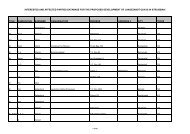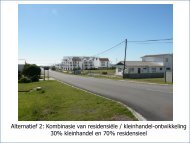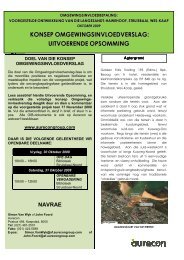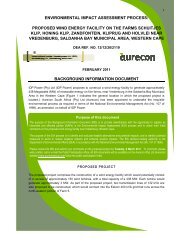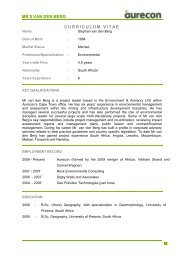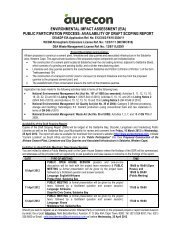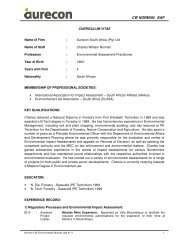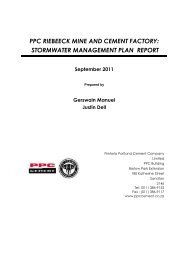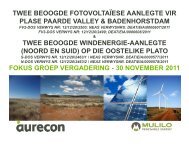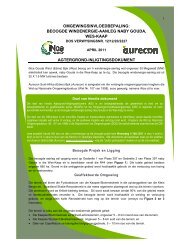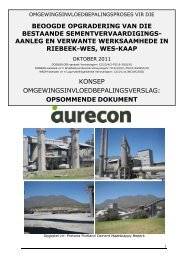Final EIAR - Aurecon AME Environmental | Environmental Projects
Final EIAR - Aurecon AME Environmental | Environmental Projects
Final EIAR - Aurecon AME Environmental | Environmental Projects
Create successful ePaper yourself
Turn your PDF publications into a flip-book with our unique Google optimized e-Paper software.
Proposed Wind and Solar (Photovoltaic) Energy Facilities on Kangnas Farm near Springbok in the Northern Cape: <strong>Final</strong> EIR 39<br />
Table 3.2 Construction and operation requirements of the four phases of the proposed<br />
wind energy facility 18<br />
PHASE A B C D Total<br />
No. of Turbines ±65 ±65 ±65 ±65 ±2 60<br />
MW Produced 140 140 140 140 5 60<br />
New Roads (km) 58.5 34 34 33 159.5<br />
Existing roads to be upgraded (km) 25.2 30.5 55.5 33.5 144.7<br />
Cables (km) 83.7 64.5 89.5 66.5 304.2<br />
Footprint (ha) 94.6 74.9 1 00.4 76.9 346.8<br />
Water (construction) (m 3 ) 64 948 60 809 66 200 61 240 253 197<br />
Water (operation) (m 3 /day) 3.4 3.4 3.4 3.4 13.6<br />
Approximately 253 197 cubic meters (m 3 ) (or an average of 87.9 m 3 per day) of water is<br />
required for the construction phase of the proposed wind energy facility is. During the<br />
operational phase it is anticipated to be 13.6 m 3 /day during peak maintenance periods.<br />
Mainstream has indicated that water could be sourced from underground sources (if available)<br />
and, if required, Mainstream will apply for a WUL once it has been confirmed that they are a<br />
preferred bidder. Mainstream will however apply to DWA and or other relevant water control<br />
authorities for a non-binding letter (project and phase specific) confirming the water availability<br />
for the proposed projects.<br />
Turbines are designed to operate continuously, unattended and with low maintenance for more<br />
than 20 years or greater than 120 000 hours of operation. Once operating, the proposed wind<br />
energy facilities would be monitored and controlled remotely, with a mobile team for<br />
maintenance, when required. There would be basic operation and maintenance including<br />
storage facilities on site.<br />
A number of jobs during the construction phases and operational phases of the proposed wind<br />
facility would be created. The proposed project would make use of local labour as far as<br />
possible. As many of the jobs as possible would be filled by people local to the wind farm area.<br />
Records would be kept of local jobs produced and the process used to procure man hours from<br />
the local market. Table 3.3 provides a breakdown of the employment opportunities for the<br />
proposed wind energy facility.<br />
Table 3.3: Employment opportunities, and breakdown per skill set, per phase of the<br />
proposed wind energy facility for a total of 750 MW windfarm development<br />
Phase Permanent Highly Skilled Skilled Unskilled<br />
Construction 285 71 403 686<br />
Operation 130 0 14 55<br />
Training would be provided for technicians to operate the facilities by the suppliers of the<br />
turbines.<br />
As per Section 2.1.5, Mainstream is planning to apply for an IPP contract in the third bidding<br />
round in August 2013. The construction period is anticipated to last 12 – 18 months for each<br />
18<br />
Note that the number of turbines is based on a 2.3 MW machine – the number of turbines would<br />
change if smaller or larger capacity turbines are to be used.<br />
© <strong>Aurecon</strong> (2012) No unauthorised reproduction, copy<br />
or adaptation, in whole or in part, may be made.<br />
P:\<strong>Projects</strong>\108495 Kangnas WEF & PV EIA's\3 Project Delivery\4 Reports\FEIR\FEIR 210213 <strong>Final</strong>.doc


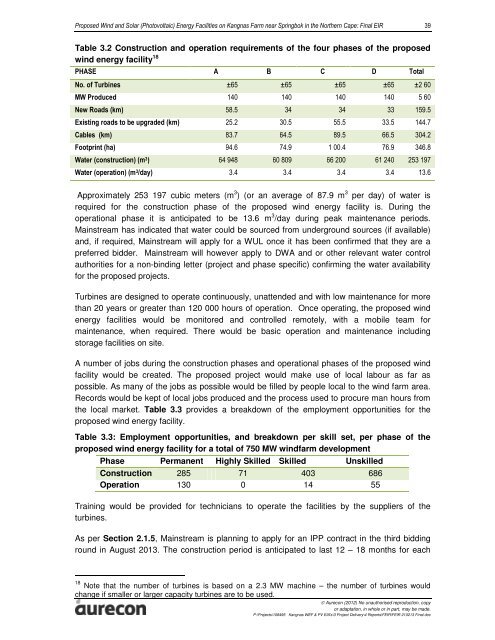
![CRR IV FEIR ~ 26042010 [FINAL].pdf - Environmental Projects](https://img.yumpu.com/21973020/1/184x260/crr-iv-feir-26042010-finalpdf-environmental-projects.jpg?quality=85)
